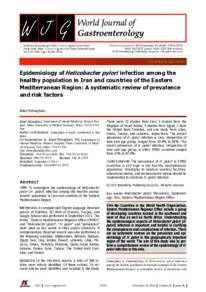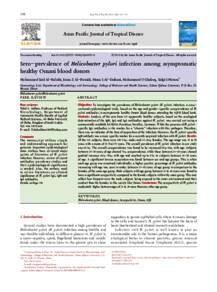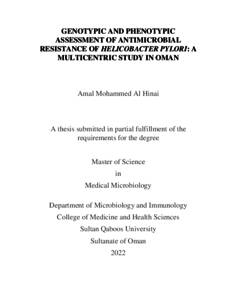Document
Epidemiology of helicobacter pylori infection among the healthy population in Iran and countries of the Eastern Mediterranean Region : a systematic review of prevalence and risk factors.
Identifier
DOI: 10.3748/wjg.v20.i46.17618
Publisher
WJG Press.
Gregorian
2014-12
Language
English
Subject
English abstract
METHODS: A computerized English language literature search of PubMed, ISI Web of Science, Scopus, and Google Scholar was performed in September 2013. The terms, "Eastern Mediterranean Regional Office (EMRO)" and "Helicobacter pylori", "H. pylori" and "prevalence" were used as key words in titles and/or abstracts. A complementary literature search was also performed in the following countries: Afghanistan, Bahrain, Djibouti, Egypt, Iran, Iraq, Jordan, Kuwait, Lebanon, Libya, Morocco, Oman, Pakistan, Palestine, Qatar, Saudi Arabia, Somalia, Sudan, Syria, Tunisia, The United Arab Emirates, and Yemen.
AIM: To investigate the epidemiology of Helicobacter pylori (H. pylori) infection among the healthy asymptomatic population in Iran and countries of the Eastern Mediterranean Region.
RESULTS: In the electronic search, a total of 308 articles were initially identified. Of these articles, 26 relevant articles were identified and included in the study. There were 10 studies from Iran, 5 studies from the Kingdom of Saudi Arabia, 4 studies from Egypt, 2 from the United Arab Emirates, and one study from Libya, Oman, Tunisia, and Lebanon, respectively. The overall prevalence of H. pylori infection in Iran, irrespective of time and age group, ranged from 30.6% to 82%. The overall prevalence of H. pylori infection, irrespective of time and age group, in other EMRO countries ranged from 22% to 87.6%.
CONCLUSION: The prevalence of H. pylori in EMRO countries is still high in the healthy asymptomatic population. Strategies to improve sanitary facilities, educational status, and socioeconomic status should be implemented to minimize H. pylori infection.
Member of
ISSN
1007-9327
Resource URL
Category
Journal articles



